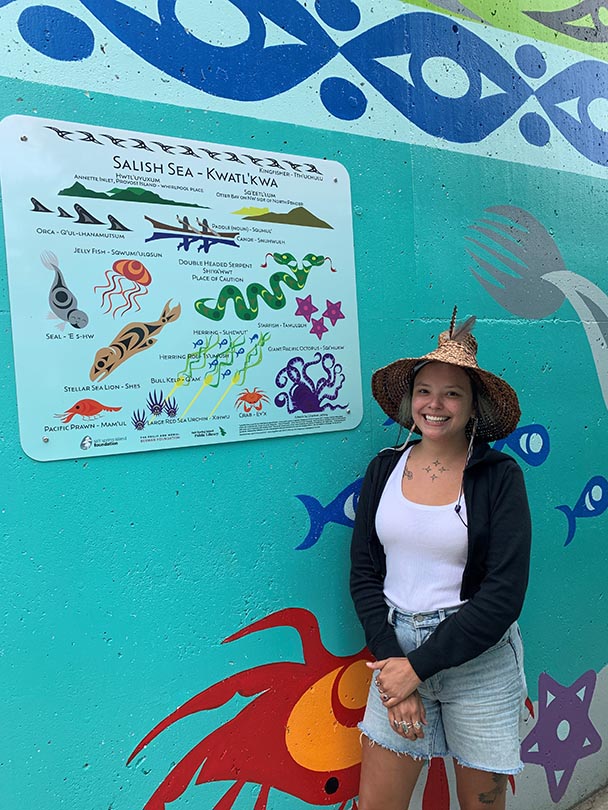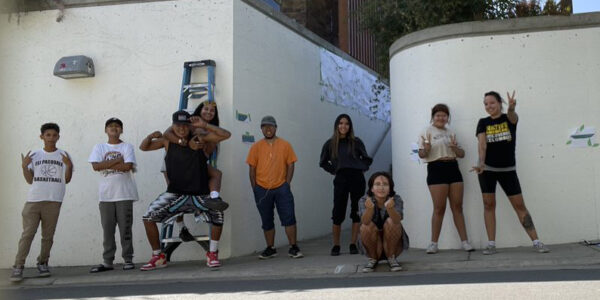 The Salt Spring Island Public Library created an Indigenous Mural with support from its community partners: Stqeeye’ Learning Society (Xwaaqw’um Project); Salt Spring Arts Council; Gulf Islands School District #64 Indigenous Education Department; Adam Olsen, MLA, as well as the C.R.D, owner of the Library building, and funding partners: The Salt Spring Island Foundation and The Philip & Muriel Berman Foundation. The Library and its partners are committed to the principles of Truth & Reconciliation and local arts projects, and are working together to create a mural by Indigenous youth representatives of First Nations in the Southern Gulf Islands region.
The Salt Spring Island Public Library created an Indigenous Mural with support from its community partners: Stqeeye’ Learning Society (Xwaaqw’um Project); Salt Spring Arts Council; Gulf Islands School District #64 Indigenous Education Department; Adam Olsen, MLA, as well as the C.R.D, owner of the Library building, and funding partners: The Salt Spring Island Foundation and The Philip & Muriel Berman Foundation. The Library and its partners are committed to the principles of Truth & Reconciliation and local arts projects, and are working together to create a mural by Indigenous youth representatives of First Nations in the Southern Gulf Islands region.
The mural was produced by Quw’utsun Artist Charlene Johnny, who mentored young artists of local Indigenous communities to create the mural on the outside of the Library building. The objective of the mural by Indigenous youth is to raise awareness of local Indigenous communities on Salt Spring, to mentor Indigenous artists, and to be a symbol of the Library and community’s commitment to Truth and Reconciliation. The project includes artistic contributions from Quw’utsun, W̱SÁNEĆ First Nations, and Penelakut peoples. With blessings from local First Nations, we hope that the design may inspire future murals on Salt Spring, kickstarting a local movement to increase public art in the village, with inclusion of Indigenous representation.
The Library opened in 2012 and, working with community partners, has co-sponsored annual Indigenous reconciliation programs. In 2018, it officially supported the recommendations presented in the Canadian Federation of Library Associations (CFLA-FCAB) Truth and Reconciliation Report and Recommendations. SSIPL has followed the recommendations as part of the 2018 Library series on the United Nations Declaration on the Rights of Indigenous Peoples (UNDRIP) by hosting speakers, including Adam Olsen, MLA for Saanich North and the Islands. The Library featured displays and art installations in the Library with First Nations Elders and families when the Library installed a permanent art exhibit honouring First Nations involvement in protecting a local burial area, Grace Islet. The Library has also hosted a continuing Reconciliation program since 2019, with Reconciliation Reading Circles led by local women of Indigenous descent.
The Salt Spring Island Public Library hopes that the mural project demonstrates a visible commitment to Reconciliation, at a time of great need for these dialogues, and creates an artistic presence of Indigenous culture in Ganges, making Salt Spring’s Indigenous presence more accessible and present to all.
Indigenous Artists
Charlene Johnny, Lead Artist, Quw’utsun
RJ (Stadskun Johnnie-Mills), Haida/Coast Salish
Marie Hardisty, Dene nation
Kielynn Dick-Charleson, Songhees and Hesquiaht nation
Jesselyn Johnny, Quatsino band, Kwakiutl, Koskimo, Naxwada
Tinaye Joy-Mujuru, Indigenous Zimbabwean of the Zezuru/Shona people
Joeluke & Darious Yellowhorn, Peigan 147 of the Piikani Nation
Linda James, Gwa’sala-‘Nakwaxda’xw tribe of the Kwakwaka’wakw nation
Sarah Jim, W̱SÁNEĆ nation
Interpretative Panel
 The mural interpretative panel, funded by the Salt Spring Island Foundation, gives the names of mural elements in English and Hul’q’umi’num’, from local Indigenous elders. Quw’utsun artist Charlene Johnny’s words are incorporated into the panel: “I painted this mural for the Salt Spring Island Public Library with a group of talented Indigenous Youth in August, 2021. Ganges Harbour was a place where we could harvest, known to us as Shiya’hwt – Place of Caution – in the Hul’q’umi’num’ language. We knew how to navigate in and out of the islands with ease and in harmony with Mother Earth. The mural shows some of the many creatures and places of Kwatl’kwa, the Salish Sea. Understanding the symbiotic relationship between art and protecting the land can transform the way we navigate within it. We are related to all beings, we are all one.” This brings awareness to the history and importance of the Salish Sea to the local Indigenous communities. Children, teachers, families as well as many visitors will now benefit from the interpretative panel and will be more engaged with the mural.
The mural interpretative panel, funded by the Salt Spring Island Foundation, gives the names of mural elements in English and Hul’q’umi’num’, from local Indigenous elders. Quw’utsun artist Charlene Johnny’s words are incorporated into the panel: “I painted this mural for the Salt Spring Island Public Library with a group of talented Indigenous Youth in August, 2021. Ganges Harbour was a place where we could harvest, known to us as Shiya’hwt – Place of Caution – in the Hul’q’umi’num’ language. We knew how to navigate in and out of the islands with ease and in harmony with Mother Earth. The mural shows some of the many creatures and places of Kwatl’kwa, the Salish Sea. Understanding the symbiotic relationship between art and protecting the land can transform the way we navigate within it. We are related to all beings, we are all one.” This brings awareness to the history and importance of the Salish Sea to the local Indigenous communities. Children, teachers, families as well as many visitors will now benefit from the interpretative panel and will be more engaged with the mural.

